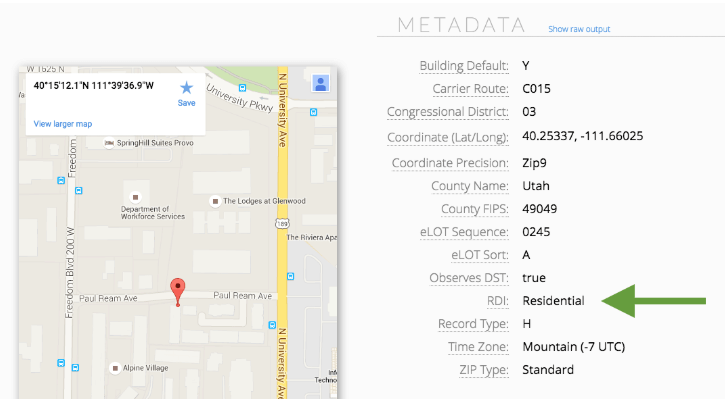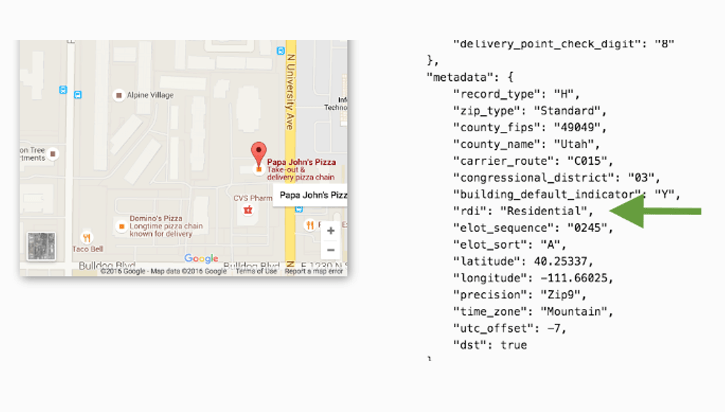USPS Residential Delivery Indicator (RDI) API for Lookup
Accurately identify residential and business locations to ensure successful deliveries to recipients while saving your business time and money.
What is Residential Delivery Indicator (RDI)?
USPS RDI, or Residential Delivery Indicator, identifies whether a U.S. address is classified as residential or business. Most shipping companies charge a higher price for residential deliveries. Businesses can use RDI data to maximize savings by flagging residential addresses and then shopping for the most cost-effective delivery option.
Examples of USPS RDI
Esendex’s Postal Address Verification API can also return RDI as METADATA like the images below.
Residential Delivery Indicator (RDI) Values
Y = Residential Delivery / Not Residential Delivery / Blank = Did Not Query RDI


Benefits of USPS Residential Delivery Indicator (RDI) API
1. Decrease Shipping Costs
A Residential Delivery Indicator API helps you save money by showing what extra costs are associated with shipping a package. This way, if there is any doubt about which carrier will provide better service for your needs and budget – the information from RDI should clear things right up!
2. Increase Efficiency
Get your packages to the right place with the residential delivery indicator. It’s an excellent way for businesses, who may not know exactly where they should be sending their package or what carrier will get it there fastest (or whose customers live in an area that requires specific sorting), as well as residents themselves when sending things like letters via surface mail—to use USPS® tracking numbers so both parties can see exactly when something was delivered! The correct data means faster shipping and more accurate addresses.
3. Avoid Rate Surcharges
Misleading anyone as to what is actually being shipped can lead you into a costly mistake. The shipping company may charge an extra fee for mislabeling addresses, so make sure your label accurately reflects the contents before sending anything out!
4. Improve Targeted Marketing
The data gathered by a residential delivery indicator can help you effectively reach your audience. Whether it’s marketing to residential or business addresses, there are specific qualities about each type of location that will affect how people receive and respond when contacted through traditional means.
5. Improve Data Accuracy
Data can be the difference between success and failure. Contact lists with accurate data provide you with more opportunities for making intelligent decisions that lead to more significant business outcomes, but adding residential or commercial address types will give even your existing contacts a layer of information they may not have had before!
When to Use Residential Delivery Indicators?
Use USPS RDI when you would like to indicate whether someone’s address is residential or business/commercial when shipping items. Shipping things from one destination to another can be difficult at times, which is why its so important for mail carriers to know whether the address their sending packages too is one or the other to reduce the returns of those sent packages.
How to Use Residential Delivery Indicators?
To use the USPS RDI, businesses must sign up for a Esendex account and obtain an API key. Once registered, businesses can then begin using the RDI to verify addresses. The RDI will return either a “RESIDENTIAL” or “BUSINESS” indicator for each address checked. Businesses can use this information to decide how to ship products and services.
What does the Residential Delivery Indicator or RDI indicate?
The Residential Delivery Indicator or RDI is a USPS API that indicates whether a given address is a residential or business address. This can be useful for businesses that want to target their marketing efforts toward residential customers or for individuals who want to make sure they are getting their mail delivered to the right place. The RDI API is relatively simple to set up and use.
Who is Residential Delivery Indicators for?
RDI is for companies looking to businesses looking to reduce residential delivery surcharges, lower shipping costs, and identify patterns to enhance efficiency and accuracy for a better customer delivery experience.
Residential Address vs. Commercial Address
Most people are familiar with residential addresses. A typical residential address includes a house number, street name, city, state, and ZIP code. A residential address may also include an apartment or unit number in some cases.
Commercial addresses are similar to residential addresses but often include additional information such as a company name or suite number. Commercial addresses may also be located in business parks or other commercial areas.
There are five critical differences between residential and commercial addresses:
- Residential addresses are typically used for private residences, while commercial addresses are used for businesses.
- Residential addresses usually include a house number, street name, city, state, and ZIP code. Commercial addresses may also include a company name or suite number.
- Residential addresses are typically located in residential areas, while commercial addresses are often in business parks or other commercial areas.
- Residential addresses are usually assigned by the local government, while commercial addresses may be assigned by the business owner or leasing company.
- Residential addresses are generally used for personal correspondence, while commercial addresses are often used for business correspondence.
Understanding the differences between residential and commercial addresses can help you ensure that your mail is delivered to the correct location.
Private Carrier ‘Residential’ vs. USPS ‘Residential’
The terms “private carrier residential” and “USPS residential” are often used interchangeably, but there are some essential differences. Private carriers like UPS and FedEx typically offer a flat rate for shipping to residences, regardless of the package size or weight. In contrast, the USPS charges by weight for shipping to residences.
Another difference is that private carriers generally deliver your package directly to your door. At the same time, the USPS may require you to pick it up from a post office or other location. Finally, private carriers typically offer faster delivery times than the USPS for shipping to residences. So, if you need your package delivered quickly, a private carrier is usually your best option
Residential Delivery Indicator FAQ’s
Get your residential delivery indicator questions answered here.
1. What is Residential Delivery Indicator (RDI)?
USPS RDI, or Residential Delivery Indicator, identifies whether a U.S. address is classified as residential or business. Most shipping companies charge a higher price for residential deliveries. Businesses can use RDI data to maximize savings by flagging residential addresses and then shopping for the most cost-effective delivery option.
2. When to Use Residential Delivery Indicators?
Use USPS RDI when you would like to indicate whether someone’s address is residential or business/commercial when shipping items. Shipping things from one destination to another can be difficult at times, which is why its so important for mail carriers to know whether the address their sending packages too is one or the other to reduce the returns of those sent packages.
3. How to Use Residential Delivery Indicators?
To use the USPS RDI, businesses must sign up for a Esendex account and obtain an API key. Once registered, businesses can then begin using the RDI to verify addresses. The RDI will return either a “RESIDENTIAL” or “BUSINESS” indicator for each address checked. Businesses can use this information to decide how to ship products and services.
4. What does the Residential Delivery Indicator or RDI indicate?
The Residential Delivery Indicator or RDI is a USPS API that indicates whether a given address is a residential or business address. This can be useful for businesses that want to target their marketing efforts toward residential customers or for individuals who want to make sure they are getting their mail delivered to the right place. The RDI API is relatively simple to set up and use.
5. Who is Residential Delivery Indicators for?
RDI is for companies looking to businesses looking to reduce residential delivery surcharges, lower shipping costs, and identify patterns to enhance efficiency and accuracy for a better customer delivery experience.
Products for a range of use cases
PROGRAMMABLE SMS API
SMS API
Texting API designed to send & receive SMS & MMS globally using a short code or 10DLC number.
NO CODING REQUIRED
SMS Software
Easy to use SMS software that can send & receive SMS & MMS using a short code or 10DLC number.
PROGRAMMABLE VOICE API
Voice Broadcast
Powerful voice API that sends mass automated phone calls quickly to mobile & landline devices.
PHONE VERIFICATION API
Phone Verification
Verify mobile & landline numbers, find service providers, & define time zones to restrict calling.
Let’s start sending, together.
